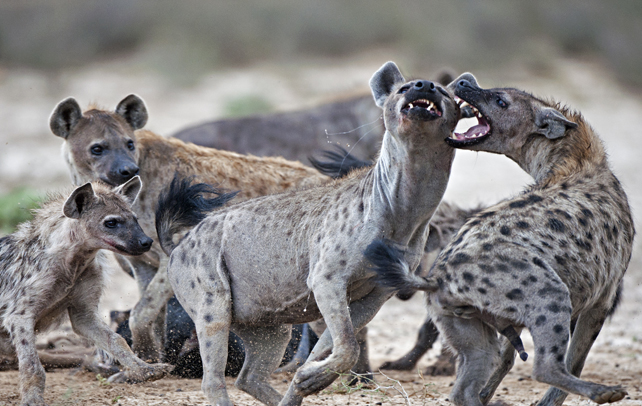Amazing Facts About Hyenas

Hyenas inhabit parts of African and Asian continents that include typical savannah, thorn bust, and stony desert. Hyaenidae, the fourth smallest biological family of the carnivore order, belongs to hyenas. Though known to be gutless and run away when threatened by other animals, there have been instances where they have charged on animals and even on humans. Contrary to popular belief that hyena only scavenges on carcasses; it hunts 90-95% (especially spotted hyenas) of meal on its own. They have extremely powerful jaw that can rip open flesh and crush bones in no time. Regarded abominable and evil in many societies, hyenas, feature in many folklore and mythologies of human culture. Following lines tell few interesting facts about this creature.
Fast Facts
Kingdom: Animalia
Phylum: Chordata
Class: Mammalia
Order: Carnivora
Family: Hyaenidae
Height: 28 to 35 inches
Weight: 90 to 190 pounds
Life Span: 25 years (in captivity)
Diet: Fresh Meat and scavenged meat
Habitat: Savannahs, grasslands, woodlands
Age of Sexual Maturity: 3 years
Gestation Period: 90 to 110 days
Interesting And Fun Facts About Hyenas
- Hyenas originated in Eurasia during the Miocene period, 22 million years ago. Later, they developed into two distinct species: the lightly built dog-like hyena and the robust bone-crushing hyena.
- Plioviverrops, one of the earliest species of hyena, originated in Eurasia around 20-22 million years ago.
- Almost15 million years ago, dog-like became extinct due to climate change and the arrival of canids, which entered Eurasia through the bering land bridge. These canids wiped out all the dog-like hyenas.
- The only hyenas inhabiting Eurasia that survived the climate changes and canids’ attacks were the bone-crushing hyenas.
- Aardwolf is the only survivor of dog-like hyena family. Unlike dog-like hyena, this specie of hyena survives on insectivorous diet, which became the main reason of their survival as the canids faced no competition from aardwolf. Their main food source is the harvester termite.
- Chasmaporthetes ossifragus was the only specie of hyena that managed to cross into the region of North America, away from the candid monopolized region. These species managed to survive on the land of North America and developed into cheetah-like sprinters.
- The four species of hyenas include: the striped hyenas from Southern Asia and Africa, brown hyena found in Southern Africa, spotted hyena from West to East and Southern Africa, and aardwolf found in the southeastern Africa.
- Hyenas live in a group called clans that can have 5-80 members.
- The hyenas are known to make numerous sounds through their vocalizations. These sounds include wailing, howling, and the most conspicuous, laughter, that is used to alert its clan members who are up to three miles away from the food source.
- Hyenas have extremely powerful digestive system and consume wide range of animals and vegetation. They can easily digest the prey’s skin, teeth, and bones. According to some campers, they have even consumed aluminium pots and pans!
- In ancient Egypt, hyenas were domesticated to be eaten.
- Female spotted hyenas are dominant over the male spotted hyenas.
- Hyenas are born with their eyes open.
- Hyenas can survive without water for several days.
- Spotted hyenas are known to devour food which can be more than one third of its body weight at a single feeding frenzy.
- Hyenas have greeting ceremonies similar to that of dogs.
- Physically, hyenas appear to resemble the canids. However, they are a different biological family. They are more related to herpestidae family, including meerkats and mongooses.
- Among all the species of hyenas, aardwolf is the smallest, weighing 50 to 60 pounds and stands at a height of only 15 to 20 inches from the shoulder.
- Hyenas are dog like creatures having front legs longer than their hind legs. It provides a sloping structure to their body, thus giving them a bear like gait.
- Hyenas are nocturnal in their habits and on an average can eat 3-6 kg of meat everyday.
- Hyenas do not kill their prey immediately. They hunt in packs and usually tire out the prey to exhaustion and then they gorge on it before it even dies.
- Female spotted hyenas are 10% larger than the males.
- Compared to their whole body size, hyenas have very strong jaw.
- Hyenas are known for their stamina and can cover long distances.
- The female members from the clan of hyenas would not mate with any male members of the same clan; they instead mate with wandering males not belonging to their clan.
- Hyenas are associated with various negative connotations in many cultures. Because of their habit of scavenging from graves, they have been associated with filth, gluttony, and cowardice.
- In order to defend their territory, the spotted hyenas form territorial clans with their relatives. The cubs are taken care of in dens that become the centre of activity for the members.
- Unlike other canids, hyenas have an additional pair of ribs
- The lower jaw or the jaw bone of hyena is stronger than other canids and therefore they can crush bones easily.
- Hyenas use anterior dentition and premolars to crack the bones while the other canids use post-carnassial molars only.
- Both striped and spotted hyenas have been recorded killing dogs with a single bite into their necks.
- The striped and brown hyena will pretend to be dead when attacked by dogs or lions while the spotted hyena will fight aggressively to defend itself.
- The cubs of spotted and striped hyenas are fully developed when they are born. Though the adult markings in the cubs of spotted hyena are missing, but the striped hyena’s cubs are born with adult markings.









